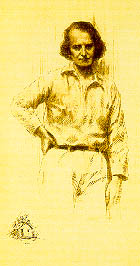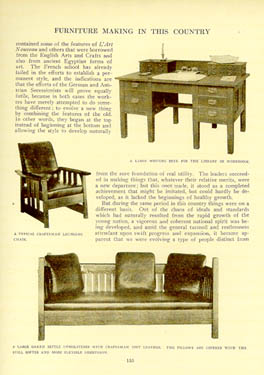 On to Midwest
On to Midwest
The Arts and Crafts Movement in America 
The Arts and Crafts Movement did not sweep America until after Morris's death in 1896. In America, two of its earliest and most successful proponents were Elbert Hubbard and Gustav Stickley. Hubbard traveled to England in 1894 (where he may have met Morris) and toured the Kelmscott Press. When he returned to the United States, Hubbard sought to emulate Morris by establishing the Roycroft Printing Shop in East Aurora, New York, in 1895.
The printing shop was very successful, publishing a hundred or so titles and several periodicals, and Hubbard became nationally famous as an essayist, editor, and publisher. In fact, visitors to the shop were so numerous that in 1899 Hubbard built an inn to accommodate them. Partly as a way to furnish the inn, the shop began producing metalwork, lighting fixtures, picture frames, rugs, and furniture. The furniture designs of the Roycroft community were influential in the movement. For example, the Roycroft "Morris Chair" did much to promote the British founder of the movement to the American public. Hubbard remained an important Arts and Crafts leader until his death in 1915.
Like Hubbard, Gustav Stickley also traveled to England, but William Morris died before Stickley had a chance to meet him. Stickley also settled in upstate New York, and in 1901 founded his own magazine, The Craftsman, to espouse the ideals of the Arts and Crafts Movement.

Stickley's philosophy closely followed that of Morris. In 1909, he stated that his magazine "stands firmly for the development in the country of a national arts and a style of architecture which shall be a true expression of the character and needs of the American people, for a form of industrial education which will develop self-reliance and initiative and foster creative ability, so that men and women alike will be able to earn their own living under any and all circumstances, and to do the best work that is in them-a training which inevitably will make for more reasonable and healthful standards of life and work both for the individual and the nation."
But it is furniture-not philosophy-which Stickley is famous for today. Usually made of oak, the furniture developed a reputation for its simple, elegant designs that celebrated the natural wood grain. It grew in popularity after it was displayed at the Furniture Exposition in Grand Rapids, Michigan, in 1900 and at the Pan-American Exposition in Buffalo in 1902.
Stickley organized his furniture workshops along the lines of a medieval guild. He sought to elevate workers by increasing their artistic input into each piece. But while Stickley's furniture was of better quality and design than that of those who would copy it, Stickley did not shy away from using machinery in its manufacturing. He used steam-powered tools to make the furniture, and hand-crafted techniques to finish it in order to evoke craftsmanship in the finished product.
An Exhibit at the Ward M. Canaday Center for Special Collections, Carlson Library, The University of Toledo.
March 26th-June 30th, 1999.